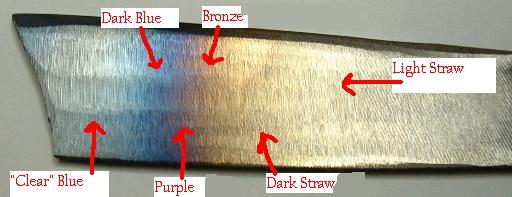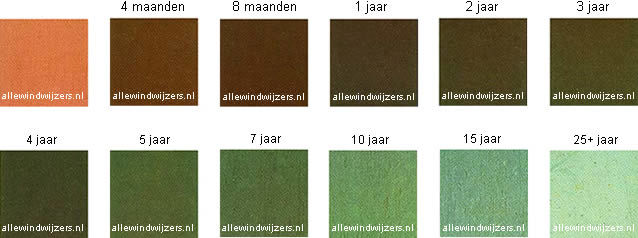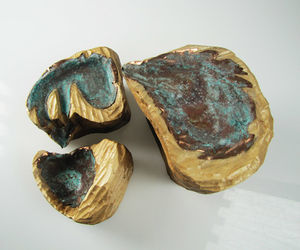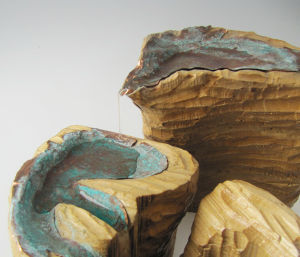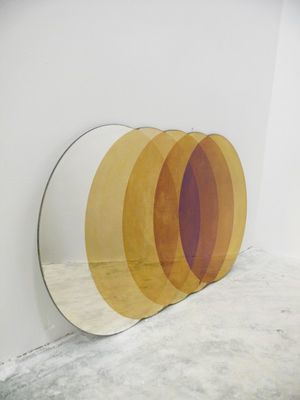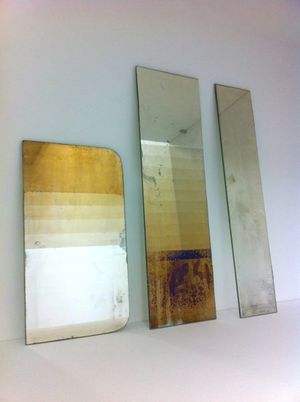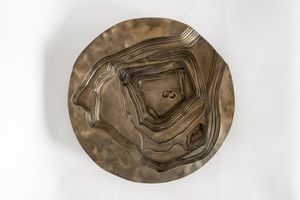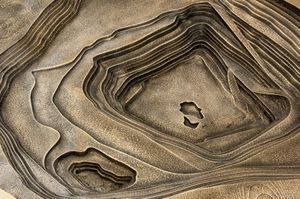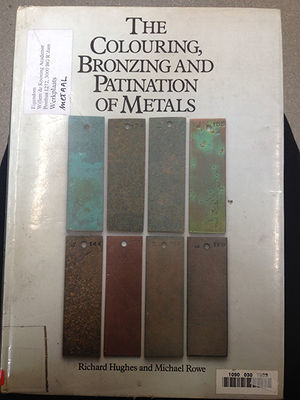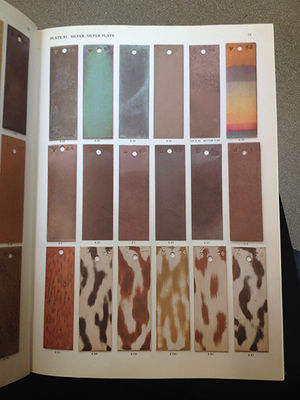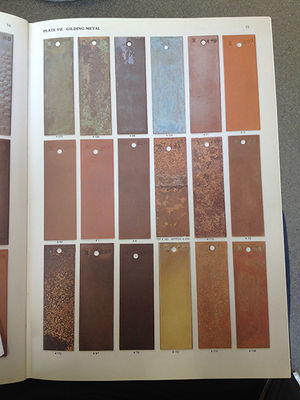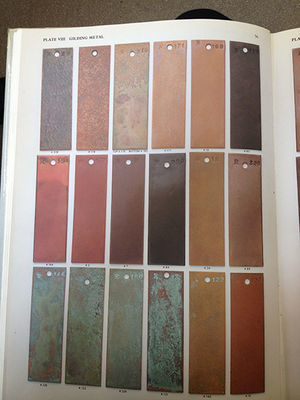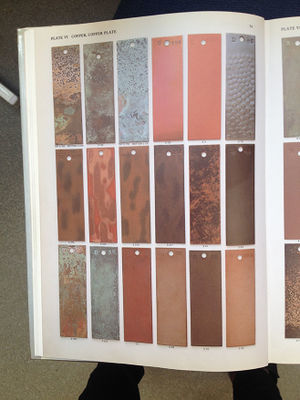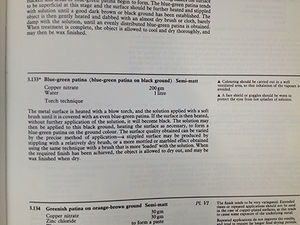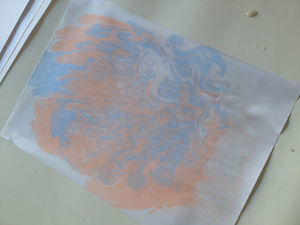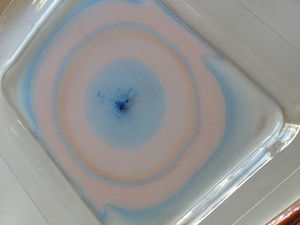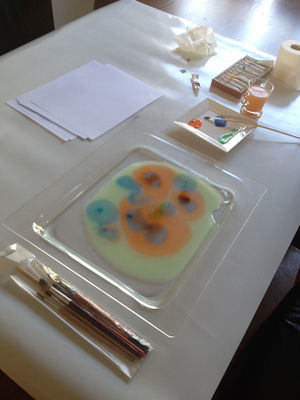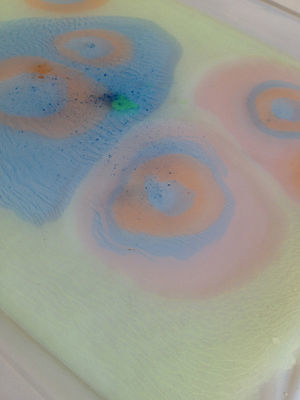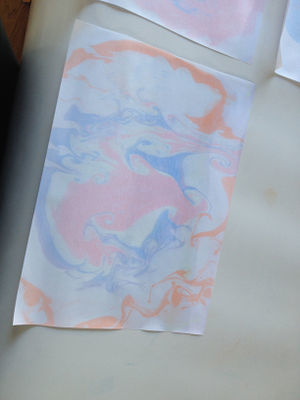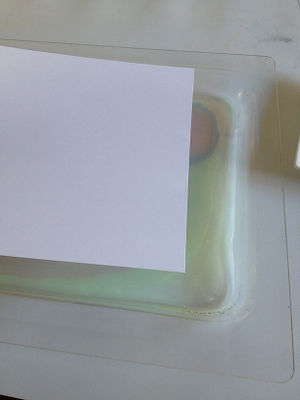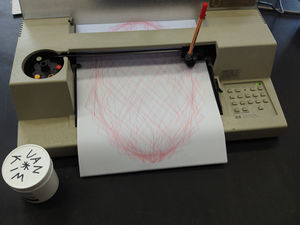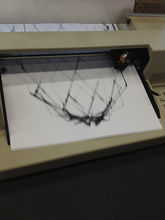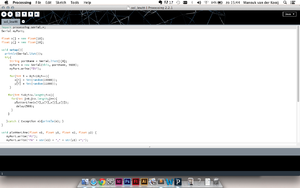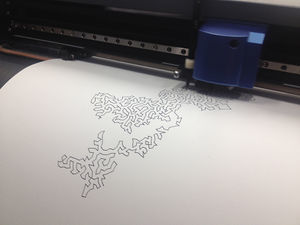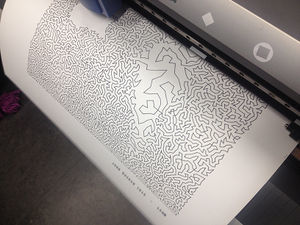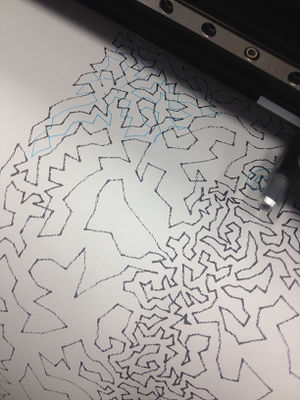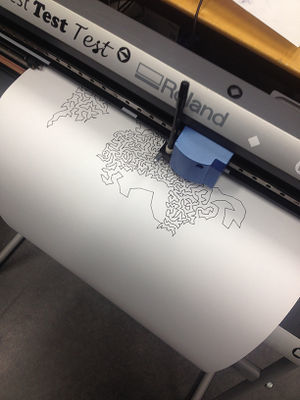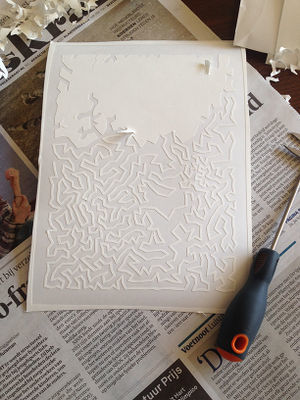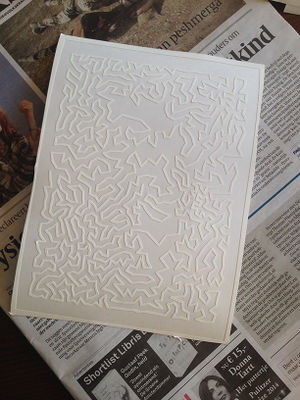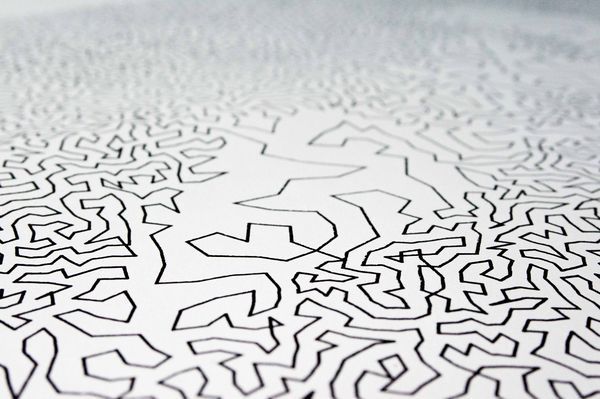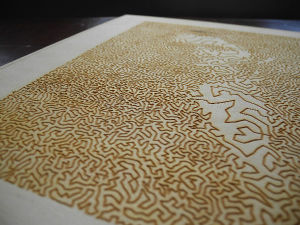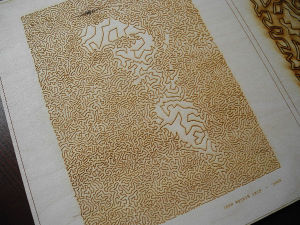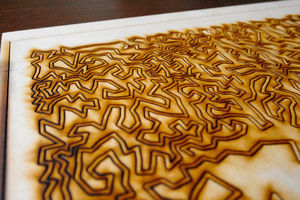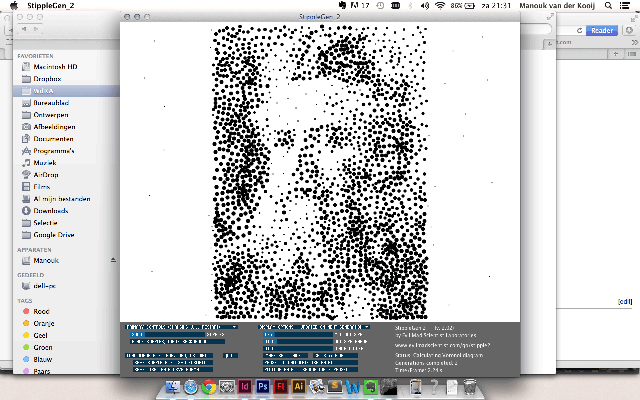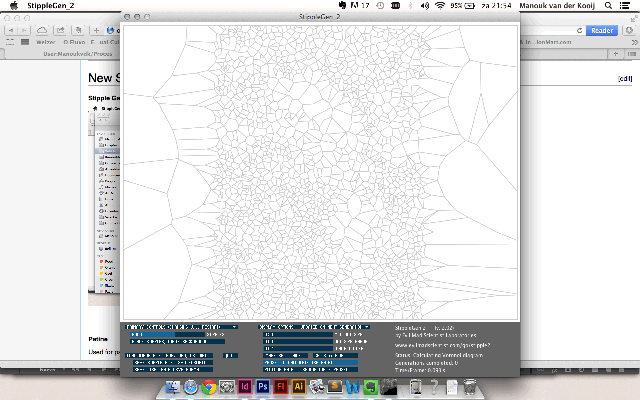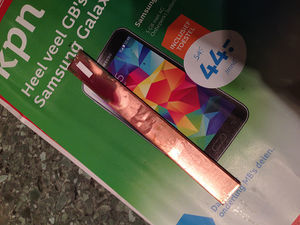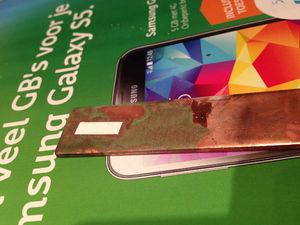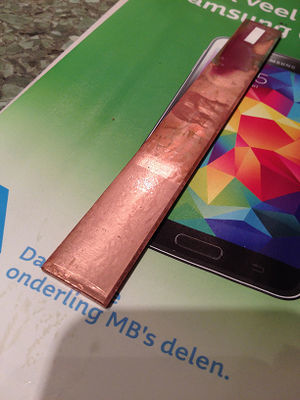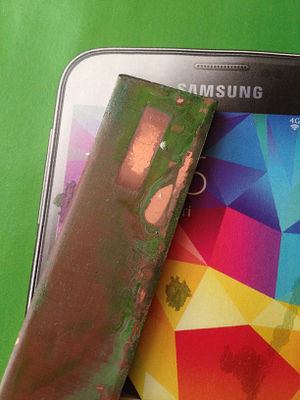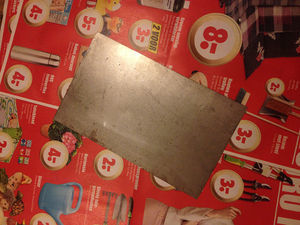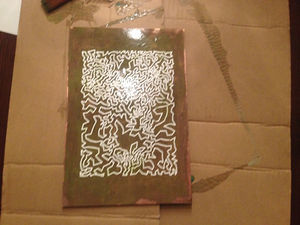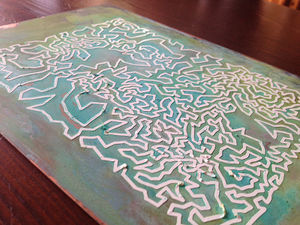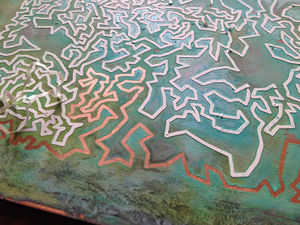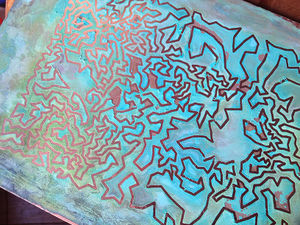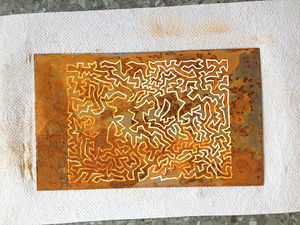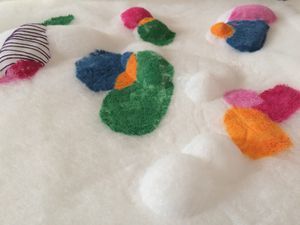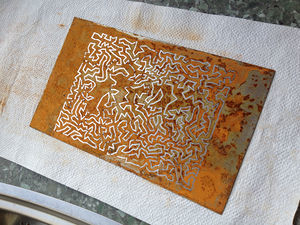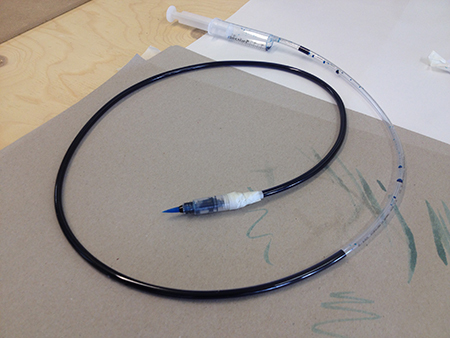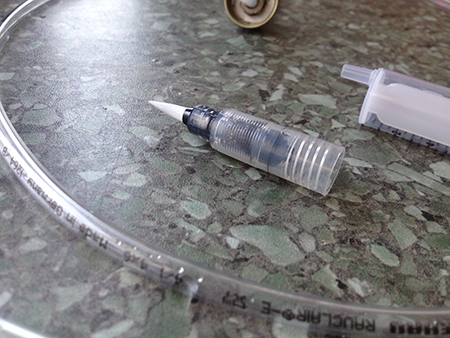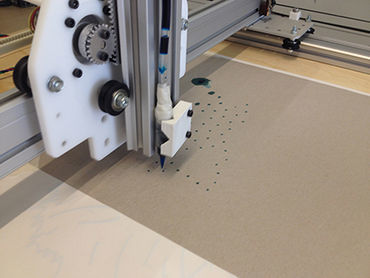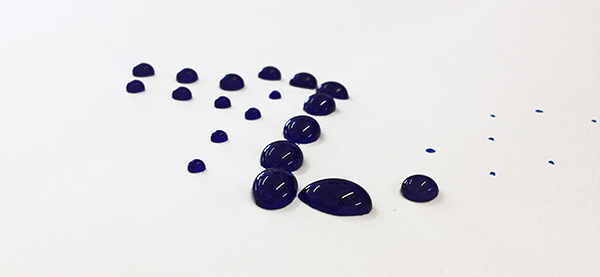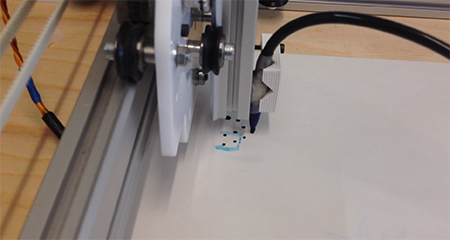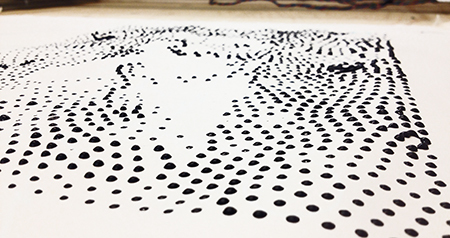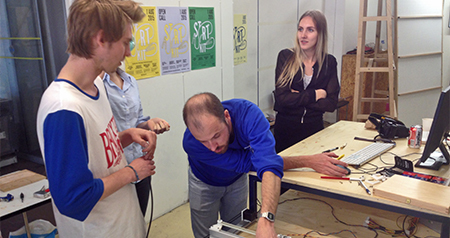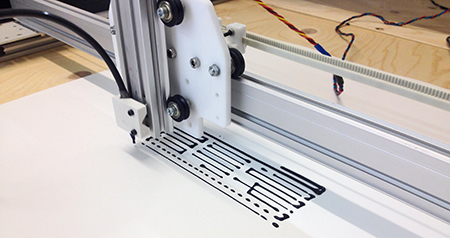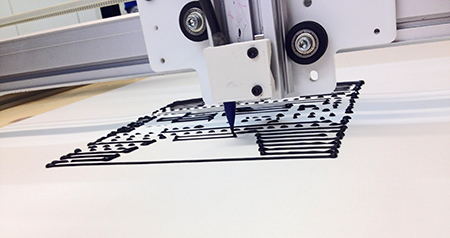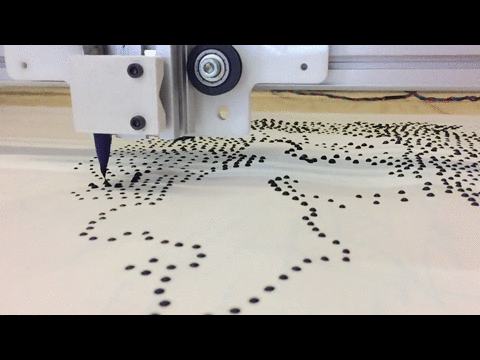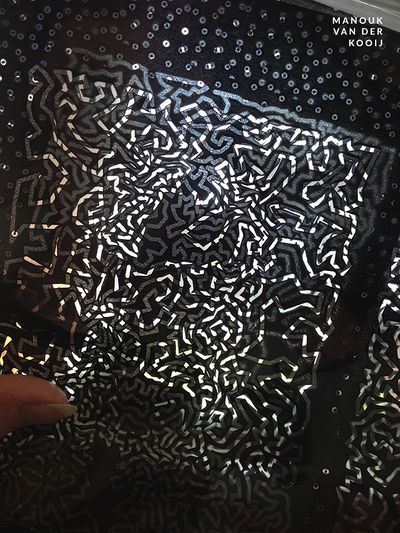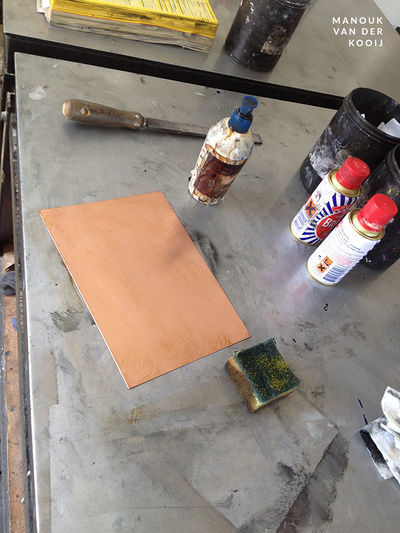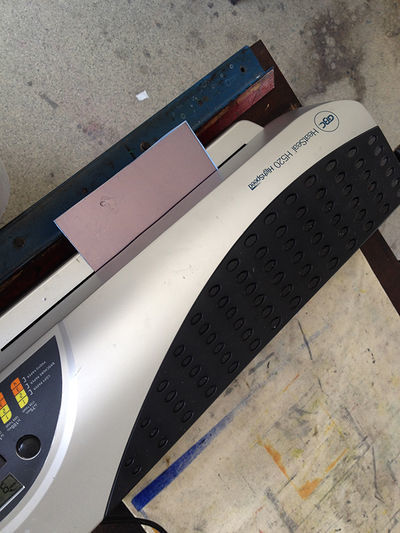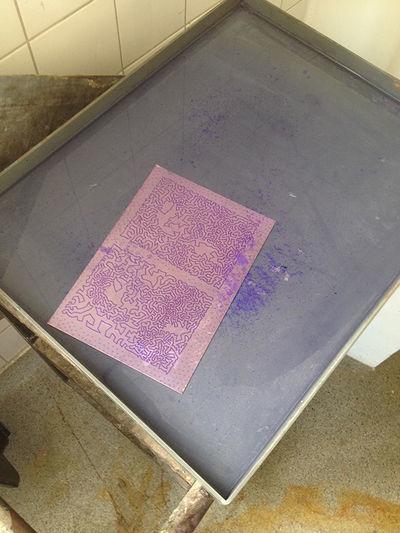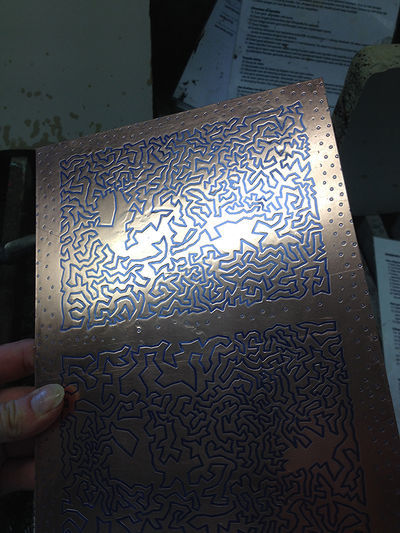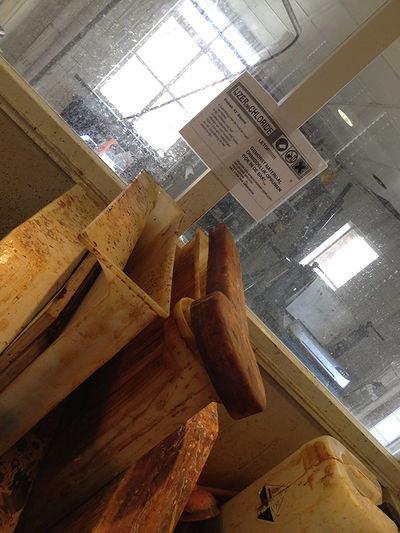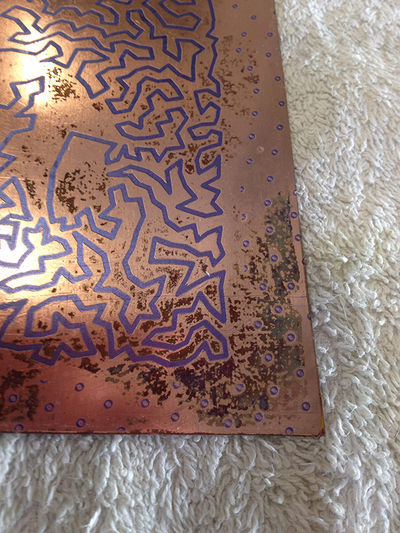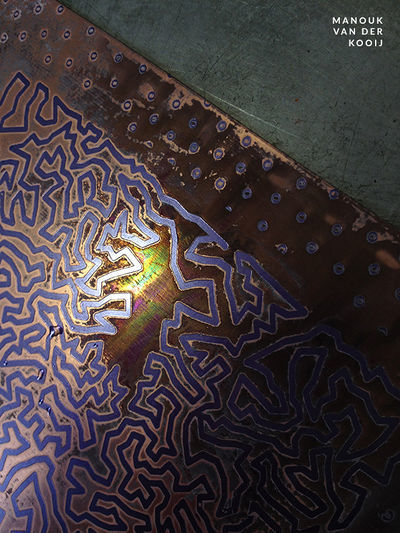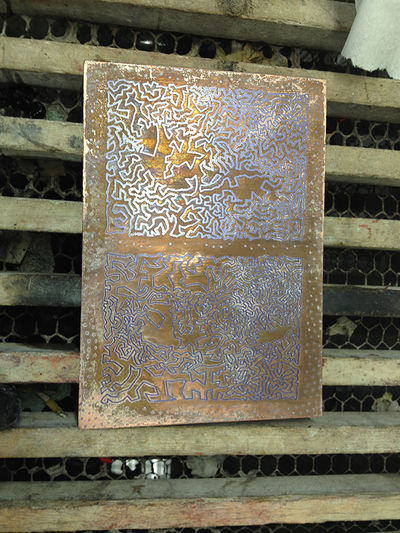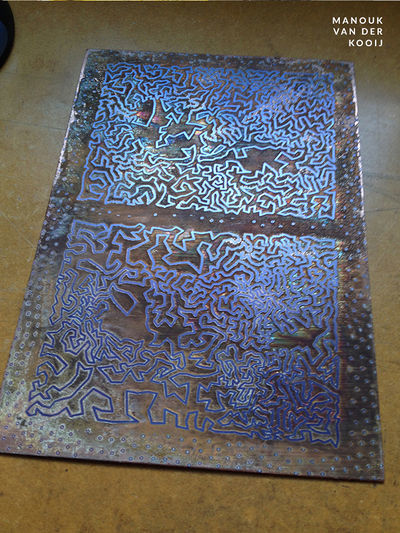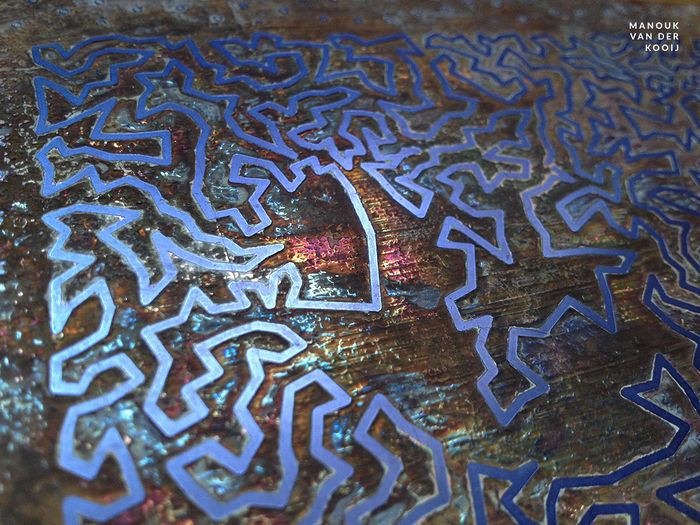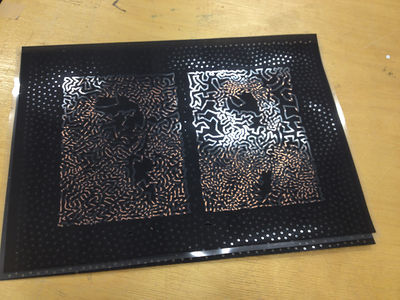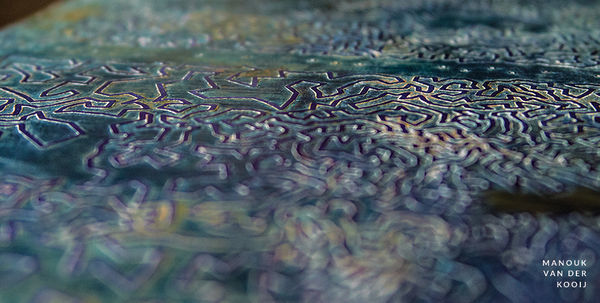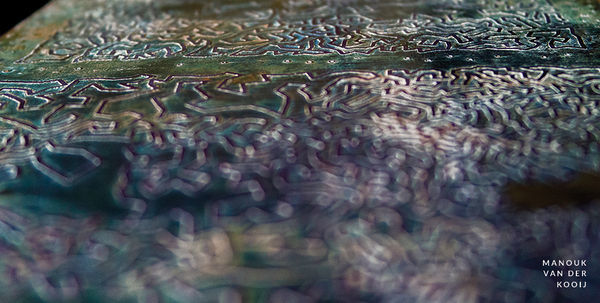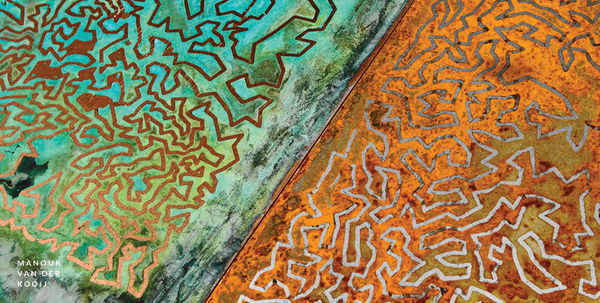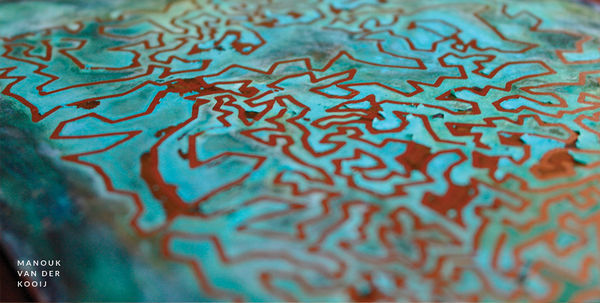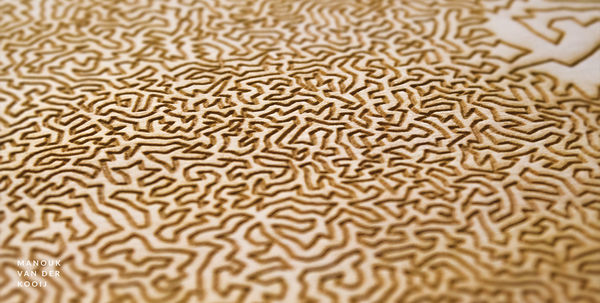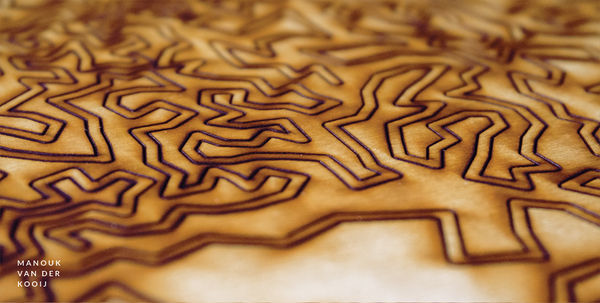User:Manoukvdk/Proces
Contents
Digital Craft Statement
From the beginning I “made” I’m very aware of my materials. I’m that kind of person where seeing and touching comes together. When I made I usually starts with how does it look and how does it feel. Unfortunately it’s a fascination I always want to control by my own and as a result It’s hard for me to make things by coincidence. It’s always kind of “controlled” and that’s really who I am.
For this course I was looking for a way to control my work and also leave it up to coincidence, it needed to be a project that comes together by controlled work from me and work that was touched by a other form of nature. This form of nature could be as an example the process that comes from oxidation or the way fire can be unpredictable. I cannot control these things.
The second thing that came up was the literal combination of Digital Craft. How became things suddenly Digital Craft and can I make a combination of the oldschool original craftworks with the new technologies these days. A project where the purity and purpose of craftwork are melted with traditions and innovations from these time. But overall Craftwork for me shows a lifetime of learning, making and changing and having the ability to combine traditional knowledge with modern thinking in order to make something beautiful.
At the start I was searching for a way to combine my visions for this project. I found out Stipple Gen a program that can generate stipple diagrams and “TSP path” art from images. It’s a great (and free) tool for turning a photo into CNC-ready artwork, for use on the Eggbot or in other contexts. The beauty in this processing program is I can upload a picture and the processing turns it into a other image. The program decides how to render this image so I can’t control it. For the base I was inspired by the theory lessons from the book “making is connecting” and the story about the founders of Arts & Craft Ruskin and Morris. I used there portraits to make a serial of objects all made with a different technique.
Soon I found out that my focus and interests were more about the abstract structures of the portraits and for me it was not about the pictures anymore. The abstract outcomes in combination with the different techniques made me very happy and satisfied about the way I have worked. By every step I made I loosed a bid of controlling the materials. For example my last work “pushing Historical Example to limits” was not just searching for limits of the technique but also looking for my own limits, it took me more than 7 hours to got this end result. It was learning proces to let go all the controls and just see what happens. I only decided what kind of image was displayed on the copper plate but had no idea what would happen after that.
For the further process I used my fasciation for the effects on natural and non-natural materials. Combine two materials that normally don’t come together. During this project, I started to experiment with the reactions on metals (oxidation , corrosion etc). I tried patination certain color reactions on different metals and combine this with original techniques.
De technieken die ik afgelopen periode heb gebruikt komen oorspronkelijk van de originele ambachten zoals etsen, carving en cutting maar ook het patineren werd door vele kunstenaars al gebruikt om het kunstwerk van een duurzame en mooie buitenlaag te voldoen. In de 19e eeuw werd deze techniek al toegepast op architectuur en beelden. In die tijd waren ze ervan bewust dat na een bepaalde periode de beelden werden aangetast door de natuur. Veel bronzen beelden zijn daarom gekleurd naar de mode van de tijd. De Romeinen bijvoorbeeld, hielden erg van zwart brons. Vanaf de vroege 19e eeuw tot het begin van de jaren zestig van de vorige eeuw koos men juist voor bruine, gele en rode tinten. Ik heb er juist voor gekozen om deze oude ambachten te gebruiken op andere manieren dus meer in combinatie met de technieken van nu. De technieken zoals de lasercutter is ontstaan uit zijn grondlegger en vertaald naar de kennis en vraag van nu. Later in het proces ben ik gaan zoeken hoe ik combinaties kon maken met deze verschillende technieken, het patineren ging samen met snijwerken van de plotter van deze tijd. En etsen heb ik toegepast met een moderne techniek door het belichten van een ontwerp op het materiaal in plaats van dit met een droge naald erop te krassen.
End result
After a while I started to make a collection of structural landscapes, each technique in combination with the materials are beautiful and fascinating characteristic objects. My love for making comes out the beauty of materials, the inspiration you get from those little pieces comes together. And the wide reach you got with one single material. Making for me is feeling, seeing and connecting the right materials together, creating a beauty of its own.
Why I make, as shown above I’m high conscious about the way materials and structures are. And I don’t know how, this quarter I suddenly realized that this could really be the main reason why I make. I make because each time I fall love with the materials, I get excited about the way something can be putted together. I make to keep exploring about all the characteristics of materials and objects. It’s a passion to search and create something that’s makes me really satisfied. I believe the best things comes out of passion, this could be the passion for the way something is printed, or just in my case how a single sheet of paper feels and searching what to do with it.
Series of 6
Simulate my research for the beauty of materials and techniques.
Showing details of the quality of each tool. Craftwork is a beauty.
Printing & Drawing
Het aanbrengen van een beeld of kenmerk van het ene op het andere materiaal.
- 3D print
- Pigment
- Röntgen
- Tattoo
- Glazuren
- Doordrukken
- Weghalen / Aantasten
- Bijvoegen
- Warmte
-
Inspiration
Metaal & Hitte [Kleuren bij verhitten]
http://www.wikihow.com/Oxidize-Copper
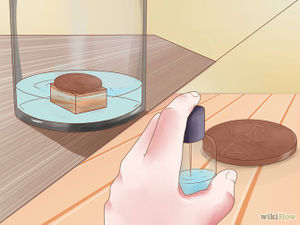
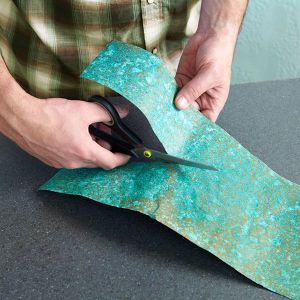
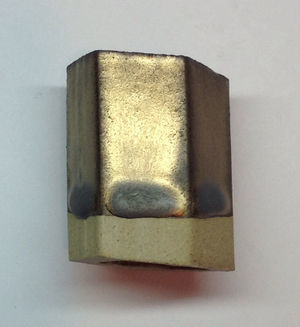
https://www.flickr.com/photos/janetlittle/5465870799/lightbox/
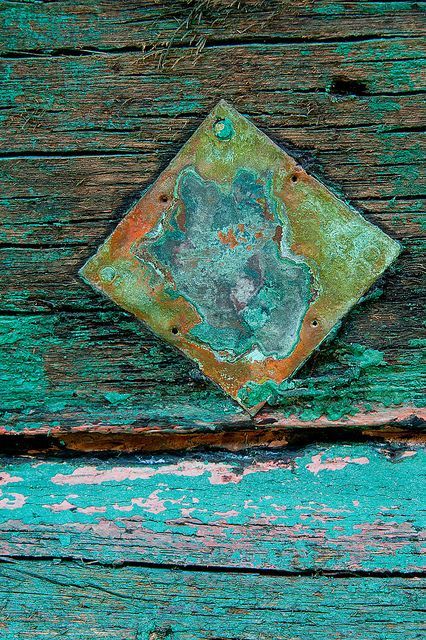
Irene Weinz, Blue Water, rings Sterling silver rings with blue enamel, oxidized. 2013 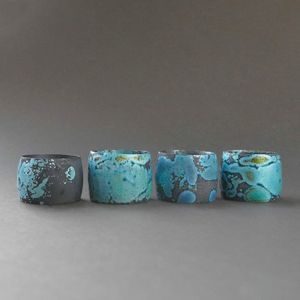 Oxydation By Periegese
Oxydation By Periegese 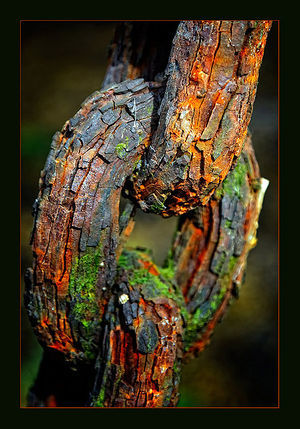
Recepten oxideren van metalen
Research Stipple Gen
Used Materials & Techniques
MATERIALS
Wood is a porous and fibrous structural tissue found in the stems and roots of trees and other woody plants.
It has been used for thousands of years for both fuel and as a construction material. It is an organic material, a natural composite of cellulose fibers (which are strong in tension) embedded in a matrix of lignin which resists compression. Wood is sometimes defined as only the secondary xylem in the stems of trees, or it is defined more broadly to include the same type of tissue elsewhere such as in the roots of trees or shrubs.[citation needed] In a living tree it performs a support function, enabling woody plants to grow large or to stand up by themselves. It also conveys water and nutrients between the leaves, other growing tissues, and the roots. Wood may also refer to other plant materials with comparable properties, and to material engineered from wood, or wood chips or fiber.
The Earth contains about one trillion tonnes of wood, which grows at a rate of 10 billion tonnes per year. As an abundant, carbon-neutral renewable resource, woody materials have been of intense interest as a source of renewable energy. In 1991, approximately 3.5 cubic kilometers of wood were harvested. Dominant uses were for furniture and building construction.
Copper is a chemical element with symbol Cu (from Latin: cuprum) and atomic number 29. It is a ductile metal with very high thermal and electrical conductivity. Pure copper is soft and malleable; a freshly exposed surface has a reddish-orange color. It is used as a conductor of heat and electricity, a building material, and a constituent of various metal alloys.
The metal and its alloys have been used for thousands of years. In the Roman era, copper was principally mined on Cyprus, hence the origin of the name of the metal as сyprium (metal of Cyprus), later shortened to сuprum. Its compounds are commonly encountered as copper(II) salts, which often impart blue or green colors to minerals such as azurite and turquoise and have been widely used historically as pigments. Architectural structures built with copper corrode to give green verdigris (or patina). Decorative art prominently features copper, both by itself and as part of pigments.
Copper is essential to all living organisms as a trace dietary mineral because it is a key constituent of the respiratory enzyme complex cytochrome c oxidase. In molluscs and crustacea copper is a constituent of the blood pigment hemocyanin, which is replaced by the iron-complexed hemoglobin in fish and other vertebrates. The main areas where copper is found in humans are liver, muscle and bone. Copper compounds are used as bacteriostatic substances, fungicides, and wood preservatives.
Aluminium is a chemical element in the boron group with symbol Al and atomic number 13. It is a silvery white, soft, nonmagnetic, ductile metal. Aluminium is the third most abundant element (after oxygen and silicon), and the most abundant metal in the Earth's crust. It makes up about 8% by weight of the Earth's solid surface. Aluminium metal is so chemically reactive that native specimens are rare and limited to extreme reducing environments. Instead, it is found combined in over 270 different minerals. The chief ore of aluminium is bauxite.
Aluminium is remarkable for the metal's low density and for its ability to resist corrosion due to the phenomenon of passivation. Structural components made from aluminium and its alloys are vital to the aerospace industry and are important in other areas of transportation and structural materials. The most useful compounds of aluminium, at least on a weight basis, are the oxides and sulfates.
Despite its prevalence in the environment, no known form of life uses aluminium salts metabolically. In keeping with its pervasiveness, aluminium is well tolerated by plants and animals.[8] Owing to their prevalence, potential beneficial (or otherwise) biological roles of aluminium compounds are of continuing interest.
Steel are alloys of iron and carbon, widely used in construction and other applications because of their high tensile strengths and low costs. Carbon, other elements, and inclusions within iron act as hardening agents that prevent the movement of dislocations that otherwise occur in the crystal lattices of iron atoms.
The carbon in typical steel alloys may contribute up to 2.1% of its weight. Varying the amount of alloying elements, their formation in the steel either as solute elements, or as precipitated phases, retards the movement of those dislocations that make iron so ductile and weak, and thus controls qualities such as the hardness, ductility, and tensile strength of the resulting steel. Steel's strength compared to pure iron is only possible at the expense of ductility, of which iron has an excess.
Although steel had been produced in bloomery furnaces for thousands of years, steel's use expanded extensively after more efficient production methods were devised in the 17th century for blister steel and then crucible steel. With the invention of the Bessemer process in the mid-19th century, a new era of mass-produced steel began. This was followed by Siemens-Martin process and then Gilchrist-Thomas process that refined the quality of steel. With their introductions, mild steel replaced wrought iron.
Further refinements in the process, such as basic oxygen steelmaking (BOS), largely replaced earlier methods by further lowering the cost of production and increasing the quality of the metal. Today, steel is one of the most common materials in the world, with more than 1.3 billion tons produced annually. It is a major component in buildings, infrastructure, tools, ships, automobiles, machines, appliances, and weapons. Modern steel is generally identified by various grades defined by assorted standards organizations.
Paper
Vinyl
Transfersheets
TECHNIQUES
Patinate
Corrosion
Etching
Lasercutter
Plotter
Printer
To do List
- Koper behandelen met licht emulsie daarna dit in zuur leggen waardoor restante delen verwijderen.
- Afdrukken op metalen maken doormiddel van zuren (zoals ontwikkelen foto's etc)
- Eigen mini plotter maken
- Electroplating
- Kan ik portretten maken uit bleek?
- Bluing (steel) [Link]
First Steps
Comparative Example
OLD VERSER NEW
The first machine I used was a printing device from the 80's. This printer only print with a processing code you need to write by yourself. At this time the machine was made, it was not capable to convert messages from a computer to a document to be printed.
New plotter
Carving & Cutting
New Skill 1.0
Stipple Gen
New Skill 2.0
Patine
Used for patinate metals
- S-39
- Hydrogen Peroxide
- Bleach
- Drain cleaner
Rusky metal
After 3 days of rain and spaying water it came out like this. You still can feel the structures that the metal created by oxidation with the typical bright colours.
Collective Example
Indianen Blob Printing
HANDMADE PRINTINGTOOL
- Aquarel Waterbrush
- Plastic tube/hose
- Hypodermic syringe
- Blue ink
After the pressure in the hose was to high we spontaneous created some thick inkblobs, we all thaugh this was very awesome but one problem.
The blobs would disappear when it dries so we had to think about a solution to keep the blobs in it's original state.
Tim came up with black acrylics but after that Roos and me fucked up the Aquarel waterbrush (ofcourse this was only made for water products).
This experiment fits in my statement because it's about searching for structures and creating a landscape by using different materials.
We created a new printinghead out off a fillable pencil thingy.
BEKIJK VIDEO [Indianen Blob Printing Video]
Pushing Limits & Historical Example
Pushing the oldway into a new technique
After experimenting with oxidize metals I wanted to push the historical etch technique to its borders. Etching I think is a wonderful technique where you make a full use of the material. It also take a few steps before you a actually can print/press your design. Because I wanted to make a combination with the new and old I choose to reflect my design on the plate instead of carving it in the first place.
With this technique you use photosensitive material like you use with silkscreen. After you reflect the design you put the plate in a bath of soda and wait till the layers comes off. In my case my design in combination with the reflecting process was too complicated. The layers wouldn’t come off as fast I was expected it would be. Using this technique and not carving was for me a way to chance the original technique and make it more impossible for myself to know what it would do and controlling it.
Deze techniek is ontstaan in het begin van de 16de eeuw en werd in de boekdrukkunst gebruikt om tekeningen te reproduceren. Hiermee konden veel fijnere prenten gedrukt worden dan met de daarvoor gebruikelijke houtsnee.
Etsen is te verdelen in drie technieken: etsen, droge naald en graveren.
Etsen is het chemisch verwijderen van metaal door zuren (inbijten). Het woord "etsen" is afkomstig van het Duitse "ätzen" dat "doen eten" betekent. Het is een proces waarbij een tekening in metaal wordt uitgebeten door een zuur met het doel er een afdruk van te maken. De tekening wordt in spiegelbeeld in de etsgrond aangebracht met een etsnaald. De door deze etsnaald uitgekraste delen van de etsgrond worden dan blootgesteld aan een verdund zuur, dat op die plaats het metaal wegvreet. Vervolgens wordt de etsgrond verwijderd, inkt in de uitgebeten delen gewreven en een afdruk gemaakt door de plaat met een vel papier bedekt onder een diepdrukpers door te halen.
USED MATERIALS FOR THIS EXPERIMENT
- Copper
- Tranfer Sheets
- Photosensitive material
- Ferric Chloride
- Brass Polisch
- Soda Solution
2 x uv light of 3 min
3 x Brass Polish
10 x soda bath about 15 min each time
4 x Ferric Chloride Bath about 1 hour each time
Structural Landscapes
Serial of landscape structures as a outcome from all the research

